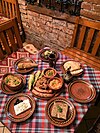Ajvar
 Open sandwich with home-made ajvar | |
| Type | Relish |
|---|---|
| Region or state | The Balkans |
| Main ingredients | Bell peppers, eggplant, garlic, chili peppers |
Ajvar ([ǎj.ʋaːr], Serbian Cyrillic: ajвар; Template:Lang-bg; Template:Lang-mk) is a type of relish, made principally from red bell peppers, with garlic. It may also contain eggplant and chili peppers. Ajvar originates in the Serbian cuisine, and was therefore long known as "Serbian salad"[1] or "Serbian vegetable caviar".[2] It became a popular salad (side dish) throughout Yugoslavia after World War II and is nowadays popular in the Balkans.
Original homemade ajvar is made of roasted peppers, while some industrial producers use cooked peppers, which leads to a lower quality. Depending on the capsaicin content in bell peppers and the amount of added chili peppers, it can be sweet (traditional), piquant (the most common), or very hot. The ajvar can be consumed as a bread spread or as a side dish.
Etymology and origin

The name ajvar comes from the Turkish word havyar, which means "salted roe, caviar" and shares an etymology with caviar.[3] Prior to the 20th century, there was a significant local production of caviar on the Danube, with sturgeon swimming from the Black Sea up to Belgrade.[4] Domestic ajvar, meaning caviar, used to be a very popular dish in Belgrade homes and restaurants.[5] However, the domestic production of caviar was not steady starting in the 1890s because of labor disputes, and eventually a special pepper salad was, with the sense for irony and an eye for production and serving, and optical similarities between the two dishes, offered as a substitute in Belgrade restaurants under the name "red ajvar" (crveni ajvar) or "Serbian ajvar" (srpski ajvar).[6]
Preparation

Original homemade ajvar is made of roasted peppers, while some industrial producers use cooked peppers, which leads to a lower quality of ajvar. The preparation of ajvar is somewhat difficult, as it involves a great amount of manual labour, especially related to peeling the roasted peppers. Traditionally, it is prepared in mid-autumn, when bell peppers are most abundant, conserved in glass jars, and consumed throughout the year (although in most households stocks do not last until the spring, when fresh salads start to emerge anyway, so it is usually enjoyed as a winter food). Often, the whole family or neighbours gather to bake the bell peppers, peel them, and cook them. The principal cultivar of pepper used is called roga, i.e. "horned" — it is large, red, horn-shaped, with thick flesh and relatively easy to peel. It typically ripens in late September.
In order to produce ajvar, bell peppers and aubergines (eggplants) are roasted whole on a plate on an open fire,[7] a plate of wood in a stove, or in an oven. The baked peppers must briefly rest in a closed dish, to allow them to cool and to allow the flesh to separate from the skin. Next, the skin is carefully peeled off and the seeds are removed. The peppers are then ground in a mill or chopped in tiny pieces (this variant is often referred to as Pindjur). Finally, the mush is stewed for a couple of hours in large pots, with added sunflower oil and garlic, in order to condense and reduce the water, as well as to enhance later conservation. Salt (and sometimes also vinegar) is added at the end and the hot mush is poured directly into glass jars which are immediately sealed.
Production
Ajvar is produced in various countries. The reported annual Serbian production is 640 tons.[8]
Ajvar is one of the so-called "zimnica" (winter foods), which include pickled chili peppers, pickled tomatoes, and anything else that can fit in a jar that gets prepared just before winter.
See also
- Ljutenica, a similar relish in Bulgarian, Macedonian and Serbian cuisines
- Pindjur, a similar relish in Bulgarian, Macedonian and Serbian cuisines
- Zacuscă, a similar relish in Romanian cuisine
- Kyopolou, an eggplant-based relish in Bulgarian and Turkish cuisines
- Biber salçası, a Turkish paste made from red peppers alone
- Lecso, a similar Hungarian (also made in parts of Slovakia and Serbia) stewed red pepper, onion, and garlic dish.
- Achar, a similar relish of Indo-European origin in South Asian cuisines
References
- ^ Joseph Slabey, ed. (1949). Slavonic Encyclopaedia. p. 338.; Lovett Fielding Edwards (1954). Introducing Yugoslavia. p. 79.; The World and it's peoples. 1965. p. 45.; Pavla Zakonjsek (1966). Praktična kuharica (Slovenian cookbook) (in Slovenian). p. 123.; Joseph Wechsberg (1960). The Cooking of Vienna's Empire. p. 164.; Thelma Barer-Stein (1979). You eat what you are: a study of ethnic food traditions. p. 576.; John Masson (1977). Lets go to Yugoslavia. p. 70.; Vera Lévai. Culinary delights. pp. 62, 169.; Malcolm Burr (1935). Slouch hat. p. 165.
- ^ Joseph Wechsberg (1960). The Cooking of Vienna's Empire. p. 164.; Thelma Barer-Stein (1979). You eat what you are: a study of ethnic food traditions. p. 576.; James Hillman; Charles Boer (1985). Freud's Own Cookbook. Harper & Row. p. 134. ISBN 978-0-06-091159-1.
- ^ Etimološki rečnik srpskog jezika I, 2003, s.v. ajvar
- ^ Josip Pančić (1860). Pisces Serbiae. p. 33.; Mihailo Petrović (1941). Đerdapski ribolov.
- ^ "Belgrade through the ages". 7. 1960: 61, 64.
{{cite journal}}: Cite journal requires|journal=(help); Dušan J. Popović (1964). Beograd kroz vekove. pp. 93, 215, 241. - ^ Malcolm Burr (1935). Slouch hat. p. 165.; Lovett Fielding Edwards (1954). Introducing Yugoslavia. p. 79.
- ^ http://biology.clc.uc.edu/Fankhauser/Travel/Macedonia/03_Macedonia/Ohrid/Making_Ajvar.JPG.
{{cite web}}: Missing or empty|title=(help) - ^ "Vegetable Industry in Serbia" (PDF). Serbia Investment and Export Promotion Agency.
External links
- "Fall Brings Red Peppers and Ajvar, 'Serbian Salsa'". NPR. November 8, 2006. (article and recipe)
- "Ajvar srpski kavijar". Novosti. 2013. Template:Sr icon
- "Leskovčanka po čijem receptu je brendiran srpski ajvar ušla u biznis kad je ostala bez posla". Blic. 2012. Template:Sr icon




